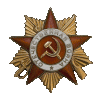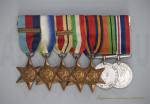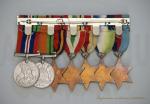-
Posts
15 -
Joined
-
Last visited
Profile Information
-
Location
Holland
Asjemenou's Achievements
-

Soviet USSR Shoulder Boards
Asjemenou replied to IrishGunner's topic in USSR: Soviet: Other Militaria
These Soviet-Russian shoulder boards (field uniform) are original but they are post war variants. M43 wartime shoulder boards for field grade officers are pentagonal. See; http://www.rkka.ru/uniform/terms/pog_arm.htm . Post war variants are hexagonal like your examples. The type of stars on the shoulder boards is for subalterns and not for field grade officers like a Mayor. The top hole in the shoulder board is for a button to fit it on the tunic. The artillery branch insignia pins with screw backs are also post war. Wartime branch insignia's have pins, which have to be fold to fit them on a shoulder board. The branch insignia should be placed between the buttonhole and the star(s). Like you already suggest the shoulder boards are made up to be sold to an ignorant tourist. I have seen the strangest combinations of rank awards, uniforms and fit together medals at the street sales in Berlin. -
More of these kinds of badges (and also coins) from former southern Soviet States are faked. Especially from Tajik and Khorezm. I have seen more examples of them. See also http://en.wikipedia.org/wiki/Tajik_Autonomous_Soviet_Socialist_Republic and http://en.wikipedia.org/wiki/Khorezm_People%27s_Soviet_Republic .
-
When I bought the group of medals I was sceptical too. I am collecting for many years and therefore I have seen a lot of fakes. The price of it was lesser than the similar sets that Mike found in the archives of an auction house. In that way it was not a wrong buy. Maybe the ribbons look quit new at the pictures but I can assure that they are discoloured. Like you suggest, without documentation of the original recipient we will never know or this group is authentic or not.
-
On basis of the stars, could it be possible to figure out on what Navy ship the veteran could have served? Is it known what British naval vessels were involved by so many operations/theatres like these during WWII? Could it also be possible that the recipient of the medals have served on several Navy ships?
-
Thank you all for your explanation. We will probably never know the truth but the statement of Odulf seems most plausible. If a forger should have composed the group than he did it carelessly. When I saw the group for sale at the military fair, I noticed immediately the 3 inverted ribbons. Despite the strange composition I leave the group as it is..
-
I also know that a maximum of 5 stars could be awarded to one veteran. What about this example; http://www.slideshare.net/scottaddington/ww2-british-and-commonwealth-campaign-medals ? If the group is a fake than it should be composed a long time ago. For putting the group together the same yarn is used. This yarn is worn everywhere in the same way. It really gives me the impression that somebody had worn the group. Would somebody like to appear in public with an impossible group of medals?
-
Thanks for your reply. The composition looks indeed unskilled. As I wrote, the medals are damaged in a proper way. The ribbons are correct discoloured. Also the threads (stiches) at the clasps and ribbons are worn and weathered. It gives me the impression that the group was composed a long time ago. I bought the group of medals a few months ago at a military fair. The seller wanted to separate the group. I can also separate them but it does not give an added value. I leave the group as it is.
-
A few months ago I bought a group of British WWII medals. Remarkable about the group is that at 3 medals the ribbons are reversed. Namely the 1939-45 star, the Atlantic star and the Africa star. Also, the 1939-45 star features the "France and Germany" clasp. As far as I know this clasp cannot be worn on the 1939-45 star. This clasp probably belongs on the Atlantic star. Despite of the errors in the composition, I do have the idea that a British WWII naval veteran wore the group. The patina and wear damage on the medals and discolorations of the ribbons (also under the 2 clasps) speak for themselves. Is it possible that the recipient of the medals has put them (invalid) together by himself? Did veterans do this more often?
-
This is what I also try to say. For me there is just one good reference to check an order or medal; I want to check it while I can see it and keep it in my hand. By Internet I will only buy it from a dealer who will give me a 100% guarantee that I can return it when I should not be satisfied. Understand me very well, I wish you that the medal is original.
-
The Polish soldiers were not the only foreigners who came to Holland during the (end of the) war. During their occupation of Holland the Germans brought a lot of foreign forced labourers to Holland. Also a lot of Dutch men were forced to work in Germany. In this way a lot of Dutchmen have met their foreign wife. Also a lot of Dutch women married a Canadian soldier right after the war. Usually they emigrated to Canada. Do I understand from earlier posts that the Italian commemorative badge of the Polish 2nd Corps can be verified because of the number at the backside?
-
It is difficult to say or this medal is original or fake. Because of the soldered on ring this medal should be a variation one. It is good to know that this medal is quit rare and therefore heavily faked. The only good reference is compare the medal with an original one! Maybe these links can help you; http://mondvor.narod.ru/MOsvBelg.html , http://collectrussia.com/DISPITEM.HTM?ITEM=28078 and http://www.soviet-medals-orders.com/medals/detailed/mm/mm46_3111_v1.shtml .
-
Thanks for reading my message. The "permission" for Polish veterans to live in Holland after the war may sound strange to you but it really happened. Beside this "permission" many soldiers of the Polish 1st Armoured Division married a Dutch woman and founded a family in Holland. Specially in the town of Breda. For that reason a lot of people in that town have a Polish family name. Breda was liberated by the Poles in October 1944. The General Maczek museum is also located in this town. This forum has interesting topics. A good reason to stay around and to post.
-
An old but interesting topic.Years ago I got some badges, medals and a belt from an acquaintance of mine. The small legacy had belonged to a Polish WWII veteran. This Polish veteran was married with an aunt of my acquaintance. This Polish veteran passed away for many years. His Dutch wife passed away nearly ten years ago. After her decease they cleared out the house and these badges, medals and belt were found. These items where given to me. The family of my acquaintance asked me or I could find out his past because they are interested in it. The Polish veteran seldom spoke about his past, so for them a little is known about him. According to the badges and medals I gather the following story; After the German invasion of Poland in 1939 the Polish veteran fled to France like so many other Poles. The army belt from his inheritance could be from his own Polish pre war uniform. In France he joined the new-formed Polish Armed Forces. He was incorporated with the Polish 2nd Rifles Division (Dywizja Strzelcow Pieszych). This Division was sent to support the French forces on the Maginot line near to the German Swiss border. During the German invasion of France in 1940 the Polish 2nd Rifles Division fought together with the French 45 Corps at Clos du Doubs. After heavy fighting’s and being cut off by the advancing Germans, the French 45 Corps and the Polish 2nd Rifles Division were backed up to the Swiss border. The French commander decided to withdraw to Switzerland, where they were interned. For taking part in these fighting’s he should be decorated after the war with the French medals. His in-laws are confirming his stay in Switzerland because they know that he had a relationship in that time with a Swiss woman. The Huguenin brothers at Le Locle, Switzerland manufactured the 2 Polish eagles from his inheritance in 1941. How long he stayed in Switzerland is unknown. Probably he escaped from Switzerland or the Polish government in exile bought him out because according to his in-laws he was also in Italy during the war. The small Italian commemorative badge of the Polish 2nd Corps can confirm his stay in Italy. Or he had taken part in the battle for Monte Cassino is not known. How the Polish veteran came to Holland is not very clear. Right after the war the Dutch government had the rule that for every killed Polish soldier in Holland, one Polish veteran may live in Holland. Probably he was one of these Poles that may live in Holland. It should be a very clear explanation how he met his Dutch wife. According to the family of my acquaintance, more medals should have been conferred to the Polish veteran. They do not know were the other decorations gone to. Maybe they were already given away to somebody else or they just lost in time. In fact I do not have any further personal information about this Polish veteran. I put up this story on various forums and I also asked the General Maczek Museum in Holland for help. Unfortunately without any results. Only the Sikorski institute in London could help me but they do not give any information to anyone who is not a close family member of the veteran. Even his in-laws have no change because they do not have the same (Polish) family name as him. The items still fascinates me but in all probability the story of the Polish veteran will be unknown forever. Polish pre war belt for soldiers. Good condition, many stamps and dated 1936. From left to right: Médaille des prisonniers civils, déportés et otages 1914-1918; conferred to civil prisoners, deported people and hostages. Croix du combattant volontaire 1914-1918; conferred to foreign volunteers who had served in the French Armed Forces. Médaille commémorative 1939-1945 with France bar; conferred to soldiers who served in the French Armed Forces during the period of September 3rd, 1939 and June 25th, 1940. The Médaille des prisonniers civils, déportés et otages 1914-1918 and the Croix du combattant volontaire 1914-1918 should also be conferred after WWII because of a short of the new type medals. Both medals should be coming from pre war stock. From left to right: Italian commemorative badge for veterans of the Polish 2nd Corps (Polski 2 Korpus); the badge was manufactured by F.M. Lorioli, Milano-Roma and given to the Polish veterans in 1946 (Order No.106 (24.IX.1946) poz.619, L.dz. 1078/AG/46). Two Polish eagle badges of the Polish 2nd Rifles Division (Dywizja Strzelcow Pieszych); the badges were designed by Bohdan Garliński and manufactured by the Hugunin brothers at Le Locle, Switzerland in 1941.




